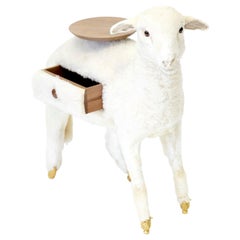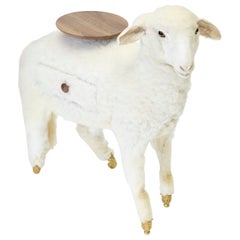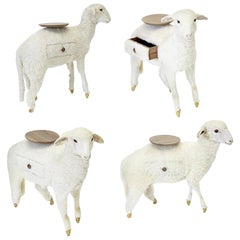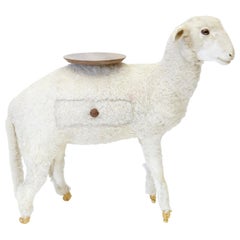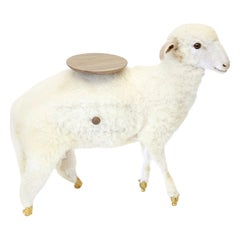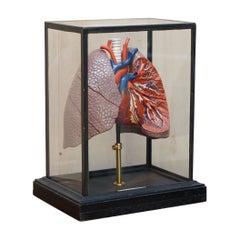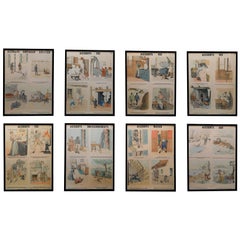Deyrolle On Sale
Salvador Dali Xai 7/20 Limited Edition
By (after) Salvador Dali, BD Barcelona Design, Deyrolle
Located in Barcelona, Barcelona
"XAI” lamb designed by Salvador Dali manufactured by BD Barcelona and Deyrolle.
Measures: 87 x 26 x H 71 (head) and H59 (back)
approximate
Inspired by the painting "Interpretation ...
Category
2010s Spanish Modern Animal Sculptures
Materials
Wool
Salvador Dali Xai 15/20 Limited Edition
By (after) Salvador Dali, BD Barcelona Design, Deyrolle
Located in Barcelona, Barcelona
"XAI” lamb designed by Salvador Dali manufactured by BD Barcelona and Deyrolle.
Measures: 87 x 26 x H 71 (head) and H 59 (back)
approximate
Inspired by the painting "Interpret...
Category
2010s Spanish Modern Animal Sculptures
Materials
Wool
Rare Set of Four Salvador Dali Limited Edition ‘Xai’
By (after) Salvador Dali, BD Barcelona Design, Deyrolle
Located in Barcelona, Barcelona
Set of four "XAI” lambs designed by Salvador Dali manufactured by BD Barcelona and Deyrolle.
This are almost the last four pieces available,
is a great opportunity to purchase it...
Category
2010s Spanish Modern Animal Sculptures
Materials
Brass
$238,392 Sale Price / set
23% Off
H 27.96 in W 34.26 in D 10.24 in
Salvador Dali Xai 3/20 Limited Edition Sculptural Table
By BD Barcelona Design, Deyrolle, Salvador Dalí
Located in Barcelona, Barcelona
"XAI” lamb designed by Salvador Dali manufactured by BD Barcelona and Deyrolle.
Measures: 87 x 26 x H 71 (head) and H 59 (back)
approximate
Inspired by the painting "Interpret...
Category
2010s Spanish Modern Animal Sculptures
Materials
Wool
$59,598 Sale Price
28% Off
H 27.96 in W 34.26 in D 10.24 in
Salvador Dali Surrealist Sculpture Side Table Model Xai Limited Edition 16/20
By Salvador Dalí, Deyrolle, BD Barcelona Design
Located in Barcelona, Barcelona
"XAI” lamb designed by Salvador Dali manufactured by BD Barcelona and Deyrolle.
Measures: 87 x 26 x H 71 (head) and H 59 (back)
approximate
Inspired by the painting "Interpret...
Category
2010s Spanish Modern Animal Sculptures
Materials
Wool
$59,598 Sale Price
28% Off
H 27.96 in W 34.26 in D 10.24 in
Fine Vintage Deyrolle Paris Anatomical Model of Human Lungs in Display Case
By Deyrolle
Located in West Sussex, Pulborough
We are delighted to offer for sale this lovely vintage French anatomical medical teaching aid of a lung with a plaque reading Anatomie Humaine, Poumons & Coeur made by Deyrolle Paris...
Category
20th Century French Other Scientific Instruments
Materials
Glass, Plastic
$3,308 Sale Price
20% Off
H 17.33 in W 13.19 in D 10.24 in
8 French Teaching Posters for Accident Prevention by Les Fils d’Emile Deyrolle
By Deyrolle
Located in San Francisco, CA
Each with four panels detailing various ways to prevent accidents and lessons learned, including 'Feu, Eau, Contagion, Empoisonnements, and Maison'; based on 19th century original li...
Category
Vintage 1950s French Napoleon III Decorative Art
Materials
Paper
$6,280 Sale Price / set
20% Off
H 32 in W 29 in D 0.75 in
People Also Browsed
Maurice Calka for Leleu-Deshays, "Boomerang" Desk, France, 1970
By Maurice Calka, LeLeu Deshays
Located in New York, NY
“Boomerang” desk designed by Maurice Calka for Leleu.
Marked: "CREATION M. CALKA EDITION LELEU DESHAYS"
This desk was exhibited in the museum show "Leleu 50 ans de mobilier et de d...
Category
20th Century French Desks
Materials
Metal
Mogens Koch for Rud Radmussen Modular Library in Mahogany
By Mogens Koch, Rud Rasmussen
Located in Waalwijk, NL
Mogens Koch for Rud Rasmussen, modular book case or library, mahogany, Denmark, design 1928
Intriguing and substantial modular library by Danish designer Mogens Koch. This piece is ...
Category
Vintage 1920s Danish Scandinavian Modern Bookcases
Materials
Mahogany
Stacked Bone and Brass Powder-Coated Table Lamp with Peekaboo Silver Leaf Shade
By Seth Premo, Arvo Ray
Located in Brooklyn, NY
The Junius lamp makes a bold statement with its geometric stacked elements that appear almost to float above one another. The lamp is constructed with a powder-coated steel shade and...
Category
2010s American Modern Table Lamps
Materials
Brass, Silver Leaf, Steel
$1,550 / item
H 18 in W 12 in D 12 in
19th Century Chinese Pagoda Cabinet
Located in Houston, TX
A stunning and rare 19th Century English Chinese pagoda cabinets. This highly stylized hand carved mahogany cabinets features, glass shelving, pagoda gabled roofs, classic Chippendal...
Category
Antique 19th Century English Chinese Chippendale Vitrines
Materials
Glass, Mahogany
Organic Modern Small Table Lamp Natural Wood Handmade Ivory Fluted Shade
By Isabel Moncada
Located in San Antonio, TX
PATA DE ELEFANTE SMALL table lamp was designed for the Atomic collection by Mexican artist Isabel Moncada.
Named Pata de Elefante –Elephant's Foot– for the prominent shape at its ba...
Category
21st Century and Contemporary Mexican Mid-Century Modern Table Lamps
Materials
Wood, Fabric, Linen, Fiberglass
$2,500 / item
H 29 in Dm 19 in
Modern Oval Coffee Table in Oak Wood Cylinder Base and Glass by Ercole Home
By Ercole Home
Located in Brooklyn, NY
Palazzo oval coffee table with green and ivory glass sits on 2 Rift White Oak Wood pedestals by Ercole Home. This new bespoke coffee table design by Ercole Home is available today fo...
Category
21st Century and Contemporary American Modern Coffee and Cocktail Tables
Materials
Art Glass, Cut Glass, Walnut
$6,500 / item
H 14 in W 36 in D 20 in
Pair of Modern Walnut Side Tables
Located in Westwood, NJ
A Pacific walnut side table, the square top with rounded corners and a reeded edge above a similar under tier, on bobbin turned legs.
Dimensions: 26" W x 26" D x 28.5" H.
Category
21st Century and Contemporary Vietnamese Modern End Tables
Materials
Wood
Surrealist Salivasofa 'Original' Prototype Red Lips Sofa By Salvador Dali
By (after) Salvador Dali, Oscar Tusquets Blanca
Located in Barcelona, ES
In the pioneering year of 1972, the visionary duo of Salvador Dalí and Oscar Tusquets unveiled their very first prototype sofa, a testament to their innovative design prowess.
Category
Late 20th Century Spanish Modern Armchairs
Materials
Foam
$550,000
H 28.75 in W 66.93 in D 39.38 in
'Plissé White Edition' Pleated Textile Table Lamp by Folkform for Örsjö
By Örsjö Industri AB
Located in Glendale, CA
'Plissé White Edition' pleated textile table lamp by Folkform for Örsjö.
This unique table lamp was awarded “Lighting of the Year 2022” by Residence Magazine Sweden, who called it “...
Category
21st Century and Contemporary Swedish Mid-Century Modern Table Lamps
Materials
Textile
$1,650 / item
H 16.1 in Dm 11.5 in
"Pietra" Curved Armchair with Leather Arms Upholstered in Bouclé Fabric
By Studio Marta Manente
Located in Centro, RS
Pietra from Italian: Stone
The designer Marta Manente is of Italian descent, her great-grandparents migrated from Italy over 100 years ago and lived in the region of Bento Gonçalves ...
Category
21st Century and Contemporary Brazilian Modern Armchairs
Materials
Bouclé
$3,969 / item
H 28.35 in W 40.16 in D 34.65 in
Sunday Daybed Oak and Boucle
Located in Plymouth, GB
Part of the Sunday collection exclusive to Fosfeen, and designed by Founder Oliver A-J, the Sunday Day Bed was designed and handcrafted in house with the finest Oak and Bouclé uphols...
Category
2010s British Mid-Century Modern Daybeds
Materials
Bouclé, Oak
New Black Wrought Iron Curule Bench with Cushion, Savonarola, Throne
Located in Miami, FL
New black wrought iron curule bench with cushion, Savonarola, Throne.
Cushion included.
Category
21st Century and Contemporary European Neoclassical Benches
Materials
Iron
$950 / item
H 25.6 in W 32.67 in D 13.78 in
Vibrant Motion: Kinetic Sculpture - Iron, Paint, Movement
By Alexander Calder
Located in Barcelona, ES
Vibrant Motion: Kinetic Sculpture - Iron, Paint, Movement
Manufactured in France by unknown artist, circa 1990.
In original condition with minor wear consistent of age and use, pre...
Category
1990s French Mid-Century Modern Abstract Sculptures
Materials
Metal
Organic Modern Floor Lamp Natural Wood Handmade Ivory Fluted Shade
By Isabel Moncada
Located in San Antonio, TX
PATA DE ELEFANTE (LARGE) floor lamp was designed for the Atomic collection by Mexican artist Isabel Moncada.
Named Pata de Elefante –Elephant‘s Foot– for the prominent shape at its ...
Category
21st Century and Contemporary Mexican Mid-Century Modern Floor Lamps
Materials
Textile, Wood, Linen, Fiberglass
Exceptional 18th Century Oak Boiserie Panel from Chateau Saint-Maclou, Normandy
Located in Dallas, TX
This fabulous hand-carved boiseries or wooden panel was recently purchased from the Chateau St. Maclou in Normandy, France. Rooms of boiseries had design motifs that were kept the sa...
Category
Antique 1750s French Architectural Elements
Materials
Oak
$9,800
H 50.75 in W 45.38 in D 4.38 in
Long Chandelier in Murano Glass by Studio Glustin
By Glustin Creation
Located in Saint-Ouen (PARIS), FR
Long chandelier in patinated brass with globes and plates in Murano glass.
Creation by Studio Glustin.
Category
21st Century and Contemporary Italian Mid-Century Modern Chandeliers and...
Materials
Brass
Get Updated with New Arrivals
Save "Deyrolle On Sale", and we’ll notify you when there are new listings in this category.
